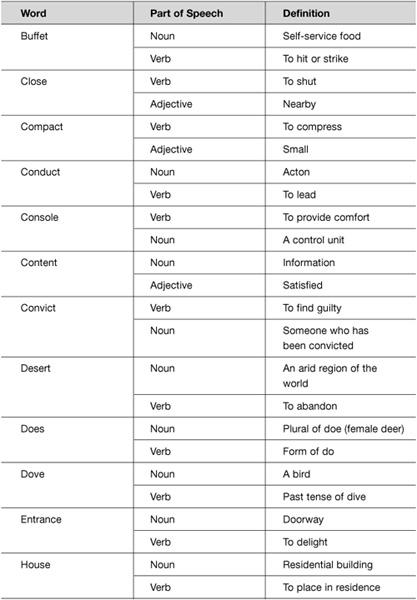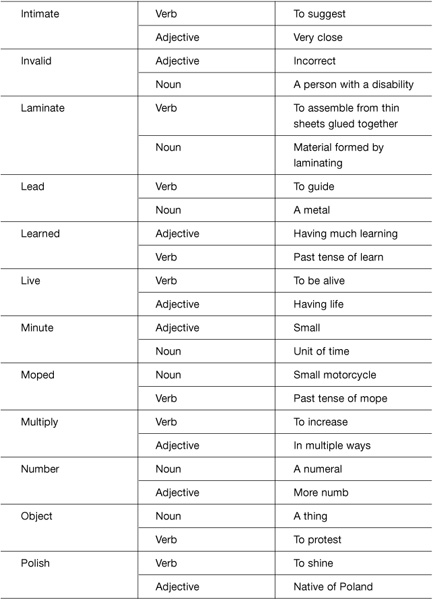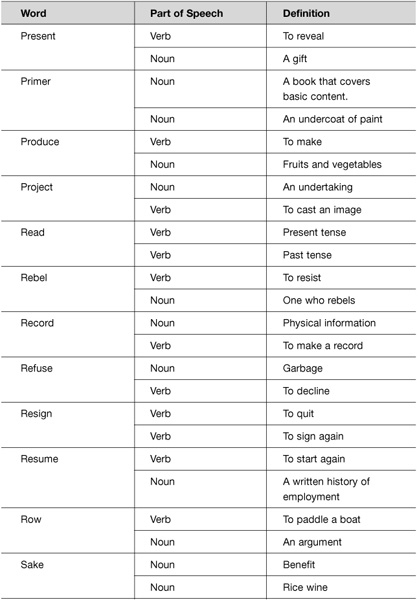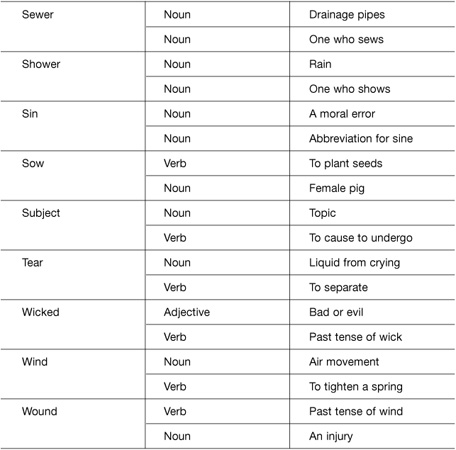H
HANDICAP, DISABILITY
A handicap is a problem that can be remedied, whereas a disability is permanent problem.
![]() People who have disabilities prefer the word disability to handicap.
People who have disabilities prefer the word disability to handicap.
![]() The phrase “people with disabilities” is preferred over “disabled people.”
The phrase “people with disabilities” is preferred over “disabled people.”
HARD DISK, HARD DRIVE
A hard disk is the actual disk inside a hard drive where data are stored in a computer system. Refer to the storage device inside most personal computers as a “hard drive” or “hard disk drive.” When using these terms, consider these tips:
![]() Hard disk and hard drive are always written as two words.
Hard disk and hard drive are always written as two words.
![]() Do not hyphenate hard disk or hard drive.
Do not hyphenate hard disk or hard drive.
HEADINGS AND SUBHEADINGS
Headings are used to organize sections of content and make it easy for readers to locate information. Consider these tips when using headings and sub-headings:
![]() Headings should convey information about the content that follows. The text that follows the heading should stand on its own and not continue where the heading left off.
Headings should convey information about the content that follows. The text that follows the heading should stand on its own and not continue where the heading left off.
Incorrect:
Printing the Document [Heading] This can be done from the File menu by clicking Print.
Printing the Document [Heading]
To print a document, click the File menu, then click Print.
![]() Avoid headings that require two or more lines of text.
Avoid headings that require two or more lines of text.
![]() Avoid using articles to begin a heading.
Avoid using articles to begin a heading.
Incorrect: The Print Dialog
Correct: Print Dialog
![]() Use the gerund form of verbs rather than the infinitive form when using headings to describe tasks (the -ing form instead of to).
Use the gerund form of verbs rather than the infinitive form when using headings to describe tasks (the -ing form instead of to).
Incorrect: To Format Your Text
Correct: Formatting Your Text
![]() Avoid terms like Using, Working with
Avoid terms like Using, Working with
![]() Use noun phrases for headings that do not involve a particular task.
Use noun phrases for headings that do not involve a particular task.
Example: Exhaust System Components
![]() Headings should not be used as a lead-in to a lone list or figure.
Headings should not be used as a lead-in to a lone list or figure.
![]() Use widow and orphan formatting controls on page layouts to prevent a heading from appearing at the bottom of one page with content following on the next page.
Use widow and orphan formatting controls on page layouts to prevent a heading from appearing at the bottom of one page with content following on the next page.
![]() Include at least two lines of text with a heading that appears at the bottom of a page.
Include at least two lines of text with a heading that appears at the bottom of a page.
Headings can be formatted on different levels with different text styles for each level. Consider these tips for heading levels:
![]() Use the same typography for a given level.
Use the same typography for a given level.
![]() Different typefaces and font styles are okay for each level.
Different typefaces and font styles are okay for each level.
![]() Level-one headings are for general information.
Level-one headings are for general information.
![]() If material that starts with a level-one heading contains subsections, the subsections should have level-two headings.
If material that starts with a level-one heading contains subsections, the subsections should have level-two headings.
![]() Keep headings on the same level parallel in their wording.
Keep headings on the same level parallel in their wording.
Example: Formatting Your Text, Adding Styles, Printing Your Document
![]() First-level headings should appear on a new page.
First-level headings should appear on a new page.
![]() Use all caps for first-level headings.
Use all caps for first-level headings.
![]() First-level headings can be centered on the page or aligned left.
First-level headings can be centered on the page or aligned left.
![]() Separate text that follows a first-level heading by three blank lines.
Separate text that follows a first-level heading by three blank lines.
![]() Second-level headings should use bold or underlined styles.
Second-level headings should use bold or underlined styles.
![]() Second-level headings should be aligned left.
Second-level headings should be aligned left.
![]() Leave one blank line before text that follows a second-level heading.
Leave one blank line before text that follows a second-level heading.
![]() Subsequent levels of headings can use bold, italic, or underlined styles.
Subsequent levels of headings can use bold, italic, or underlined styles.
![]() Use standard paragraph spacing for the text that follows subsequent-level headings.
Use standard paragraph spacing for the text that follows subsequent-level headings.
HELPING VERBS
HENDIATRIS
Hendiatris is a figure of speech where three words are used to emphasize one idea.
Example: Wine, women, and song
Example: Eat, drink, and be merry.
Hendiatris is often used to create mottos for organizations.
Example: The motto at West Point is “Duty, Honor, Country.”
HETERONYMS
Words that are spelled the same but that have different meanings and are pronounced differently are heteronyms. Heteronyms are also known as hetero-phones. Table 2.17 lists common heteronyms.
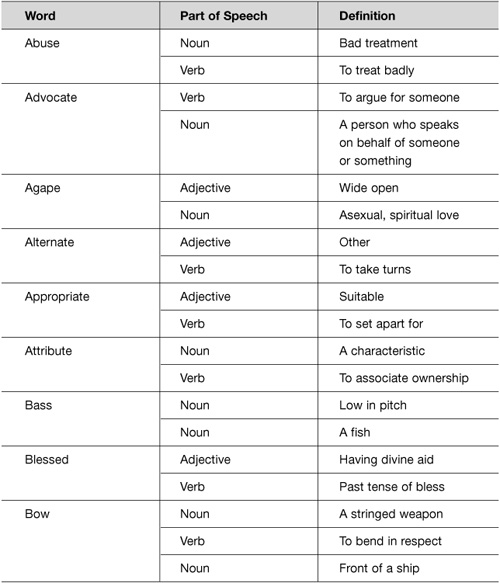
HIGHLIGHTING
Highlighting is a technique for changing the font or font style for a word or phrase to add emphasis. Techniques include using italics, bold, all caps, underlines, and different sizes and colors. Using too much highlighting is distracting.
In business and technical documents, highlighting is typically used:
![]() To emphasize the word not in statements
To emphasize the word not in statements
![]() In headings
In headings
![]() For software commands, menus, fields, and buttons
For software commands, menus, fields, and buttons
![]() In special notices such as warnings, cautions, or dangers
In special notices such as warnings, cautions, or dangers
![]() For buttons on computer hardware
For buttons on computer hardware
![]() As labels in figures
As labels in figures
![]() In titles for a table
In titles for a table
![]() For column headings in a table See Chicano, Latino, Hispanic.
For column headings in a table See Chicano, Latino, Hispanic.
HISPANIC, LATINO, CHICANO
See Chicano, Latino, Hispanic.
HIT
When writing about keyboard actions, use type or press instead of hit.
HOMOGRAPHS
Homographs are similar to homophones and homonyms in that they are words that are spelled the same but have different meanings.
Example: I’m going to read the book.
Example: I read that book last week.
Example: The wind blew through the trees.
Example: You have to wind the old clock.
HOMONYMS
Homonyms are words that are pronounced the same, spelled differently, and have different meanings. Table 2.18 contains a list of commonly confused homonyms.
Table 2.18 Commonly Confused Homonyms
HOMOPHONES
Words that are spelled differently but sound the same are homophones.
Example: to, two, too; birth, berth
HYPALLAGE
Hypallage is a literary technique that involves reversing the normal relation of two words.
Transferred epithet is a type of hypallage that involves applying an adjective to the wrong word in a sentence.
Example: “the winged sound of whirling” [instead of “the sound of whirling wings”]—Aristophanes, Birds
HYPERBATON
Hyperbaton is a figure of speech that occurs when two words that normally go together are separated for effect.
Example: “This is the sort of English up with which I will not put [instead of “put up with”].”—Winston Churchill
Example: “Object there was none. Passion there was none.” —Edgar Allan Poe, The Tell-Tale Heart
HYPERBOLE
Hyperbole is a figure of speech that occurs in exaggerated statements that should rarely be taken seriously. Hyperbole is used to create emphasis and to be humorous.
Hyperbole often involves an overstatement or understatement.
Example: I have a million things I should be doing right now.
Example: I’m so hungry, I could eat a horse.
Example: I nearly died laughing.
HYPERLINKS
Hyperlinks are text or buttons that allow a user to click and access another document or a different place within the same document.
Hyperlinks are often found in Web sites and online documents. One of the most common hyperlinks is a Web address (URL).
Hyperlinks that link within the same document are sometimes called bookmarks. Text hyperlinks within a document are normally highlighted with either bold, underlining, or a different color.
HYPHENS
Hyphens are used to join words, to show a connection between words, or to separate the syllables for a single word when splitting a word for a line break. Hyphens are used for various purposes.
Line Breaks
![]() Break closed compounds between the words.
Break closed compounds between the words.
Example: peace-/keeping
![]() Break hyphenated compound words after the hyphen.
Break hyphenated compound words after the hyphen.
Example: user-/friendly
![]() Break multisyllable words at the end of a line.
Break multisyllable words at the end of a line.
![]() Don’t break one-syllable words.
Don’t break one-syllable words.
![]() Don’t break a word if just one letter is left on either line.
Don’t break a word if just one letter is left on either line.
Substitute Words
If a word repeats with a different modifier in a sentence, the repetition can make the sentence sound long and difficult. One way to solve this problem is to use a hyphen.
Example: We both over- and underestimated the amount of driving time for the trip.
Example: The football team used a three-, four-, and five-man line.
Example: Most computers today have either a 32- or 64-bit processor.
Pronunciation
You can use hyphens when writing dialogue to achieve a particular pronunciation in the reader’s mind.
Example: “S-s-s-s” said the snake.
Example: “Mr. S-s-smith,” he stuttered, “May I p-p-please have some w-w-water?”
Compound Adjectives
Compound adjectives are groups of words or phrases used in a sentence to describe a noun.
Example: It was a once-in-a-lifetime opportunity.
Example: I wouldn’t touch that line with a ten-foot pole.
Example: The computer’s processor has a 512-single-byte bus.
Example: Eight-month-old kittens were given away.
Do not use hyphens when the first word of a compound adjective ends in -ly.
Incorrect: It was a highly-motivated student body.
Correct: It was a highly motivated student body.
Incorrect: It was a beautifully-made sweater.
Correct: It was a beautifully made sweater.
HYPHENATED COMPOUND WORDS
The following is a list of commonly used hyphenated compounds:
![]() all-encompassing
all-encompassing
![]() anti-inflammatory
anti-inflammatory
![]() cold-shoulder
cold-shoulder
![]() co-worker
co-worker
![]() dead-on
dead-on
![]() do-able
do-able
![]() ex-employee
ex-employee
![]() multi-item
multi-item
![]() nuclear-free
nuclear-free
![]() pre-engineered
pre-engineered
![]() self-doubts
self-doubts
![]() stand-in
stand-in
![]() water-resistant
water-resistant
![]() all-knowing
all-knowing
![]() back-check
back-check
![]() community-wide
community-wide
![]() cross-fertilize
cross-fertilize
![]() de-emphasize
de-emphasize
![]() drop-kick
drop-kick
![]() ex-husband
ex-husband
![]() non-native
non-native
![]() off-color
off-color
![]() president-elect
president-elect
![]() self-esteem
self-esteem
![]() time-out
time-out
HYPHENATED NUMBERS
Consider the following hyphenation tips when working with numbers:
![]() Written-out numbers of less than one hundred are hyphenated.
Written-out numbers of less than one hundred are hyphenated.
Example: thirty-three
![]() Hundreds and thousands are not hyphenated.
Hundreds and thousands are not hyphenated.
Example: six hundred thousand
![]() When modifying a noun, numbers are hyphenated, as are any compound adjectives.
When modifying a noun, numbers are hyphenated, as are any compound adjectives.
Example: five-thousand-foot mountain
Example: three-foot rule
![]() Fractions of less than one are hyphenated.
Fractions of less than one are hyphenated.
Example: one-third
Example: three-quarters
![]() Mixed numbers are not hyphenated between the whole number and the fraction, both when written as words and figures.
Mixed numbers are not hyphenated between the whole number and the fraction, both when written as words and figures.
Example: one and one-half
Example: 1 1/2
![]() Do not write one part of the fraction as a numeral and the other as a word.
Do not write one part of the fraction as a numeral and the other as a word.
Incorrect: 1 fourth-inch bolt
Correct: one-fourth-inch bolt
HYPONYMS
Hyponyms are words that are in categories of other words.
Example: Red, scarlet, and crimson are all hyponyms of red.
Example: Red, green, and blue are all hyponyms of color.
HYPOPHORA
Hypophora is a figure of speech where the writer or speaker asks a question and then answers it.
Example: “What is George Bush doing about our economic problems? He has raised taxes on people driving pickup trucks and lowered taxes on people riding in limousines.”—Bill Clinton
HYPOTHETICAL QUESTIONS
A hypothetical question is a question that is based on assumptions instead of facts and that is intended to elicit an opinion. Hypothetical questions are often asked of politicians and during court trials.
HYSTERON PROTERON
Hysteron proteron is a literary technique that calls attention to an important idea by placing it first and then having a secondary idea direct attention back to the first.
Hysteron proteron involves an inversion of the normal sequence of events for effect or humor.
Example: Put on your shoes and socks, but not necessarily in that order.

